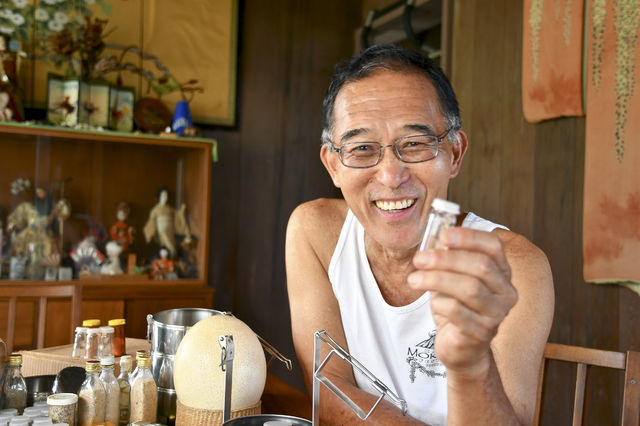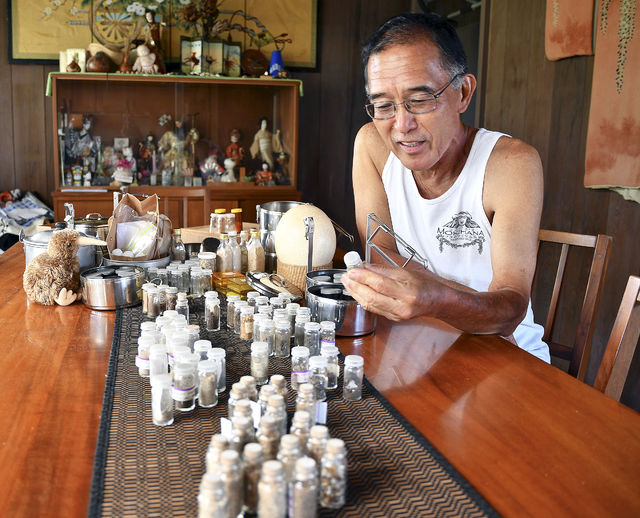Bon Dance and Gerald Hirata
Gerald Hirata grew up in a plantation camp on the Westside and traveled halfway around the world with the Peace Corps before returning to his Kauai roots eight years ago.
He now dedicates his efforts and energies to preserving the temple of his youth and the traditions of the bon dance. He will share both with the community at the Kauai Soto Zenshuji Bon Dance Festival tonight and Saturday in Hanapepe.
“I’ve always described myself as a local, Wahiawa boy, whose life was shaped by this little, dusty, McBryde enclave in the middle of a sugar canefield,” Hirata says.
His childhood was spent in Camp 2 and Camp 3, established by McBryde in 1899 when the company first started. Both his father and grandfather worked for McBryde.
“Camp 3 was mostly Japanese. Camp 2 where I grew up was mostly Filipino.”
In 1903, a Zen Buddhist temple was established in Camp 3, the first of its sect to be established in Hawaii and the Americas.
The temple and the Japanese community shaped the character of Camp 3, Hirata said. All activities, social, cultural and religious, centered around the church, the Japanese Language School and the social hall.
“It was a community full of life,” he said.
Little League baseball, Friday night movies, camp picnics, youth activities at the Hall, a summer Bon Dance, bazaars, and a New Year’s party were just some of the events camp residents enjoyed.
The precepts of Buddhism and the Japanese culture were the source of many of the values youth acquired.
“Buddhism helped bridge the gap between generations because it allowed us to understand the values of our parents and grandparents, and stressed the cult of the family,” he said.
Buddhism and their Japanese values “allowed us to make the most of an impoverished situation. It made the rough times of labor unrest and sugar strikes easier to bear,” Hirata said.
The church and its teachings also shaped their attitudes and ways of interacting with people. They learned to be humble, low key, and have consideration when dealing with others.
“We were taught that other people’s reactions were important so it determined how we behaved,” Hirata said, adding that they learned to respect and to accept one another and developed a sensitivity for sharing and caring.
Eleele School became his “window to the world.” He learned of other places beyond Kauai from books, magazines, newspapers, and atlases.
“I knew an interesting world existed out there,” he said. He spent hours poring over maps and atlases, memorized the capitals of all 50 states. He knew the names of all the countries in the world, its rivers, mountains, capital cities, etc.
Growing up on Kauai gave Hirata deep roots and a good solid foundation of family and community values.
“It provided me with a strong sense of identity and a good feel of who I was. I was comfortable in being Japanese, or Japanese-American, local, or Hawaiian-American.”
In 1965, he attended Arizona State University in Tempe, Ariz. but wasn’t impressed by life in the college classroom. What was more intriguing for him was living in this Anglo dominant culture, and meeting Native Americans for the first time.
Dormitory life was also an experience. He got to meet students from different parts of the US and foreign countries.”
The landscape was at the same time intriguing and baffling.
“The Phoenix area was called “The Valley of the Sun.”
“Valley? I thought where is the valley?” He thought of valleys back home, Hanapepe, Waimea, Hanalei.
“You drive in, cross a river and drive out. And the valley winds its way up to the mountains,” Hirata said.
In Arizona, the valley was a flat desert, the Salt River was dry, and the mountains were far, far away.
“All of the information I read in the atlases did not prepare me for this.”
In his senior year, he applied to join the Peace Corps, as a volunteer, something he had dreamed of doing ever since reading an article as about the program as a sophomore in high school.
Eventually he was accepted as a volunteer teacher in math and science and assigned to Botswana, Africa, the furthest you could get away from Hawaii, exactly halfway around the world.
“It was the best thing I ever did in my life,” he says now.
While he did encounter the discrimination encountered by non-white South Africans, “my experience in Botswana however was wonderful.” He especially enjoyed school vacations when he would return and visit my adopted family in a village about 200 miles north of where I was teaching.
His Peace Corps experiences could fill an entire column alone. He was in Botswana for three years. Thirty years later, he returned and was pleased with what he found. Botswana is now one of the most stable democracies in Africa. What’s more, largely due to mining operations, the country once considered one of the poorest in the world has now been transformed to a middle-income entity. When he left, there were 12 secondary schools in the country. Today, there are 245.
Many of those he taught when he was there are now doctors, lawyers, or occupying the highest ranks in the president’s cabinet. They have become leaders in the country he once lived in. Many express their gratitude for the impact Peace Corps volunteers made on their lives.
“My experience as a Peace Corps volunteer was transformative. I learned about the human condition,” he said.
“Most of all however, my three years in Africa made me learn about myself,” he added. “The civil strife, turmoil in that region of Africa, and the practice of institutionalized racism, makes you think hard about life, your place in it, who you are, what you are, your role and your place in society.”
When he returned to Hawaii at the age of 24 years, he had already circled the globe, traveled, experienced many cultures in many lands and had gained a lifetime of experiences.
Asking himself what he was going to do now, he decided the only way to figure things out was to get back in the classroom again. He felt he could get a good graduate education in Los Angeles. There was also good work experience available.
“I call myself, a ‘born again Buddhist,’” as I returned to the temple of my youth in 2008, when the elders who were my parents peers, asked for help. It was difficult to say no, as I had strong childhood memories of a very close-knit community, having tight bonds with neighbors and other Wahiawa camp families, as if they were relatives.”
He became heavily involved, with the temple’s daily operations, serving as the president of the board of directors.
“Since 2008, our temple has been without a minister. Like many other Buddhist temples in Hawaii, we face the challenging issue of survivability,” he said.
“Buddhism came to Hawaii when Japanese immigrants worked in the sugar plantations. Today, those sugar communities do not exist so the traditional membership base is no longer sustainable,” he said, adding that he feels the churches are not changing fast enough to serve the broader community.
Buddhism left India, went to China and became Chinese Buddhism. It went to Japan and became Japanese Buddhism. And the same for Thailand, Vietnam, and Myanmar.
“We should be moving toward creating Hawaiian or American Buddhism,” he said.
“As the statewide president of the Soto Zen association, I feel I can be a voice of change and I take my role and responsibility seriously.”
His life has now come full circle.
“I’ve returned to celebrating my own Japanese-American heritage and want to ensure that our rich folk and cultural traditions are kept alive,” he said.
In the last five years, he has been involved in preserving the Bon dance culture of song, music, and dance.
“With only two singers then, we now have about five and the training continues,” he said. “Then we could count the number of drummers with two hands, and now we have nearly 30! If you look at the dance ring, the numbers astound me with participation from all segments of the community. It’s quite a sight to see the diversity, not just in terms of ethnicity, but age and gender as well.”
He also is proud that the Okinawan eisa dances are back.
“In 2012 at Soto Zen Temple, we featured eisa for the first time in nearly 50 years and it is now an essential part of our temple’s Bon, as it was when I was growing up,” Hirata said.
“The spirit of bon is to remember your ancestors and honor those who have passed; those who have come before you,” he said.They believe that the spirits of those who have passed return during the season, using the light of the lanterns to who the way to come back and return.
Like his Peace Corps experiences, he is so knowledgeable about bon, the “dance of joy,” and is committed to preserving its traditions and enhancing and adding to them. He is a wealth of knowledge on the subject that could again fill an entire column on its own.
At this year’s Kauai Soto Zenshuji Bon Festival, eisa will again be featured as will a performance of becho, a lively spirited dance that is unique to Hawaii. They will be explaining and talking about the dance and bring it back as part of their cultural performance. Everyone is invited to attend to enjoy and learn more about these unique performances.
Gerald Hirata is grateful there are so many people living what they always did.
“Maybe they are not aware but they are contributing to preserving the past,” he said.
“Let’s document things, remember our history so we have something nice to enjoy and be proud of,” he said. “Let’s make sure this continues so we can teach it to our children and our grandchildren.”
•••
Rita De Silva is a former editor of The Garden Island and a resident of Kapaa.
All bon odori begins at 7:30 p.m.
• Tonight, Saturday: Kauai Soto Zenshuji, Hanapepe
• July 29-30: Koloa Jodo Mission
• Aug. 5-6: West Kauai Hongwanji, Hanapepe Temple



